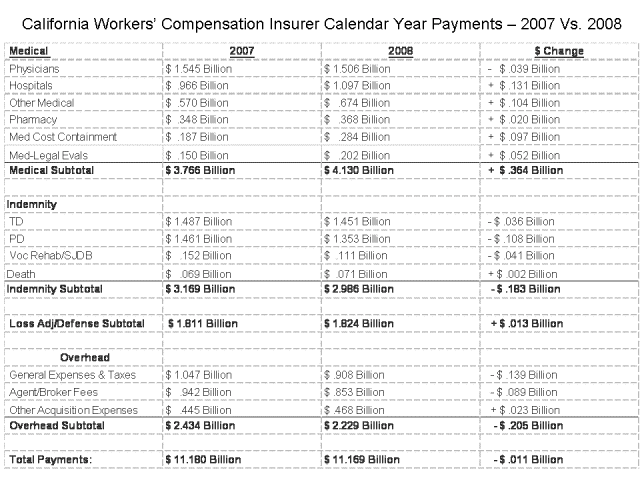California workers’ compensation earned premium fell by $2.3 billion to less than $11 billion last year, while insurers’ loss and expense payments totaled nearly $11.2 billion, resulting in a pretax underwriting loss of $84 million according to a CWCI analysis of the Workers’ Compensation Insurance Rating Bureau’s annual report to the governor and legislature on workers’ compensation calendar year losses and expenses.
The Rating Bureau’s annual compilation of workers’ comp insurer experience, released June 25, shows earned premium gross of deductible credits or recoveries and not including retrospective rating, dividends or nonstandard coverage, fell from $13.27 billion in 2007 to $10.93 billion last year, which was less than what insurers’ paid out for medical, indemnity and administrative expenses. Medical and indemnity payments alone accounted for $6.9 billion of the insurer’s calendar year 2008 payments – while the total rises to $7.12 billion if the $212 million in payments by the California Insurance Guarantee Association are added in. Insurers also added $35 million in reserves for future claim payments, so excluding the CIGA payments, insurers’ incurred losses came in at 63 percent of earned premium. Adding in overhead, loss adjustment and defense payments pushed the total to 100.5 percent of earned premium.
The biggest increase was on the medical side, where total payments jumped $364 million to more than $4.1 billion. Among the medical payment categories, reimbursements to physicians topped $1.5 billion and remained the biggest medical component, even though that total was down $39 million from 2007. In contrast, hospital payments rose $131 million to nearly $1.1 billion; “other medical costs” were up $104 million (primarily due to a $98 million increase in medical payments made directly to injured workers under compromise and release agreements) medical cost containment (fees for MPN access, bill review and utilization review) jumped $97 million to $284 million; med-legal evaluation costs increased $52 million to $202 million; and pharmacy payments rose $20 million to $368 million.
On the indemnity side, aggregate indemnity payments were down $183 million for the year. Leading the decline were permanent disability payments, which fell $108 million from the 2007 total, while total insured payments for vocational rehabilitation/supplemental job displacement benefits were down $41 million; and temporary disability payments were down $36 million. The only indemnity component that registered an increase was death benefits, which edged up by $2 million to $71 million last year.
Insurers’ overall loss adjustment and defense payments were up just a fraction last year, rising $13 million to $1.824 billion, but insurers did reduce their total overhead expenses by $205 million as general expenses and taxes fell by $139 million and declining premium helped push agent and broker fees down $89 million, which more than offset a $23 million increase in other acquisition expenses.
The following table compares California workers’ compensation calendar year 2007 and 2008 payments broken out by payment category. CWCI members and Research/Bulletin subscribers may also log on to the CWCI website at www.cwci.org to access Bulletin 09-11, which provides a more detailed summary. In addition, the public may access the full WCIRB Report, which includes exhibits on the cause and nature of injury and the part of the body injured, based on data from policy year 2006 individual case reports on TD, PD, and death claims with more than $5,000 in incurred costs, at https://wcirbonline.org/wcirb/resources/data_reports/pdf/2008_loss_and_expenses.pdf.

